Construction of Ecological and Recreation Patterns in Rural Landscape Space: A Case Study of the Dujiangyan Irrigation District in Chengdu, China
Abstract
:1. Introduction
2. Methods
2.1. Research Design
2.2. Study Area
2.3. Types of Data
2.4. Analysis
2.4.1. Construction of Ecological and Recreational Space
2.4.2. Analysis of Multiscale Landscape Connectivity
2.4.3. Principal Component Analysis
2.4.4. Construction of the Resistance Surface
2.4.5. Identification of Corridors
3. Results
3.1. Spatial Distribution of Ecological and Recreational Patterns
3.1.1. Spatial Analysis of a Single Factor
3.1.2. Analysis of Ecological and Recreational Spatial Patterns
3.2. Changes in Landscape Connectivity and Scale
Recreational principal component factor2 = −0.144 ∗ CONTAG + 0.147 ∗ COHESION + 0.416 ∗ DIVISION + 0.436 ∗ SHDI + 0.194 ∗ SHEI − 0.006 ∗ AI
3.3. Identify Ecological and Recreational Sources
3.3.1. Set the Minimum Area Threshold
3.3.2. Source Identification
3.4. Identification of Ecological and Recreational Corridors
3.5. Comprehensive Pattern of Ecology and Recreation in the Dujiangyan Irrigation District
4. Discussion
4.1. Analysis of Regional Landscape Patterns
4.2. Optimization of the Source Identification Method
4.2.1. Optimization of Multiscale Landscape Connectivity
4.2.2. Effect of Patch Size on Source Recognition
4.2.3. Optimization of the Multifactor Resistance Surface Construction Method
4.3. Implications to the Development of the Dujiangyan Irrigation District
5. Conclusions
Author Contributions
Funding
Data Availability Statement
Conflicts of Interest
Appendix A
| Criterion Layer (A) | Sub-Criterion Layer (B) | Weight | Factor Layer (C) | Conditions for Reclassification | Value | Weight |
| Importance evaluation of ecological protection | Ecological Sensitivity Evaluation (B1) | 0.6410 | Elevation (C1) | Elevation > 700 m | 5 | 0.1644 |
| 600 m < Elevation < 700 m | 3 | |||||
| Elevation < 600 m | 1 | |||||
| Slope (C2) | Slope > 25° | 9 | 0.1833 | |||
| 15° < Slope < 25° | 7 | |||||
| 8° < Slope < 15° | 5 | |||||
| 3° < Slope < 8° | 3 | |||||
| Slope < 3° | 1 | |||||
| Aspect (C3) | North | 9 | 0.1356 | |||
| Northeast, Northwest | 7 | |||||
| East, West | 5 | |||||
| Southeast, Southwest | 3 | |||||
| South | 1 | |||||
| Spatial distribution of water resources (C4) | 0–20 m buffer for rivers, 0–10 m buffer for ponds | 9 | 0.3052 | |||
| 20–50 m buffer for rivers, 10–20 m buffer for ponds | 7 | |||||
| 50–100 m buffer for rivers, 20–50 m buffer for ponds | 5 | |||||
| 100–200 m buffer for rivers, 50–100 m buffer for ponds | 3 | |||||
| >200 m buffer for rivers, >100 m buffer for ponds | 1 | |||||
| Land-use type (C5) | Waters, woodland | 9 | 0.2114 | |||
| Farmland | 7 | |||||
| Land for construction, wasteland | 1 | |||||
| Spatial assessment of ecological importance (B2) | 0.3590 | Security of water resources (C6) | Large area of water, distance <20 m | 9 | 0.5666 | |
| Medium-area waters, distance <50 m | 7 | |||||
| Relatively concentrated small waters, distance <100 m | 5 | |||||
| Dispersed small waters, distance ≤150 m | 3 | |||||
| No water, distance >150 m | 1 | |||||
| Vegetation coverage (C7) | Coverage > 60% | 9 | 0.2833 | |||
| 45% < Coverage ≤ 60% | 7 | |||||
| 35% < Coverage ≤ 45% | 5 | |||||
| 20% < Coverage ≤ 35% | 1 | |||||
| Disturbance of development and construction to ecology (C8) | The density of traffic, villages and towns is very low, 1000 < population ≤ 2000 | 9 | 0.1501 | |||
| The density of traffic and villages is low, with a population of 2000–3000 | 7 | |||||
| The density of traffic, villages and towns is moderate, 3000 < population ≤ 4000 | 5 | |||||
| The density of traffic, villages and towns is high, 4000 < population ≤ 5000 | 3 | |||||
| The density of traffic, villages and towns is very high, and the population is more than 5000 | 1 | |||||
| Suitability evaluation of recreational space | Suitability evaluation of recreational space development (B3) | 0.5564 | Spatial distribution of tourism resources (C9) | Jenks Level 5 classification | - | 0.3100 |
| Spatial distribution of tourism service facilities (C10) | Coverage, no coverage | 1, 9 | 0.2728 | |||
| Spatial distribution of heritage sites and potential tourism resources (C11) | Place of protection | 9 | 0.4172 | |||
| 50 m buffer in the protected area | 5 | |||||
| 100 m buffer of the protected land | 1 | |||||
| Evaluation of recreation needs (B4) | 0.4436 | People’s demand for the abundance of recreational activities (C12) | Jenks Level 5 classification | - | 0.7407 | |
| People’s demand for community leisure space (C13) | - | 0.2593 |
| Principal Component | Ecological Principal Component | Recreational Principal Component | ||||
| Eigenvalue | Contribution Rates/% | Accumulative Contribution Rate/% | Eigenvalue | Contribution Rates/% | Accumulative Contribution Rate/% | |
| 1 | 5.250 | 87.497 | 87.497 | 3.452 | 57.532 | 57.532 |
| 2 | 0.598 | 9.959 | 97.456 | 2.255 | 37.590 | 95.122 |
| 3 | 0.105 | 1.743 | 99.199 | 0.255 | 4.244 | 99.367 |
| 4 | 0.047 | 0.786 | 99.986 | 0.037 | 0.621 | 99.988 |
| 5 | 0.001 | 0.014 | 99.999 | 0.001 | 0.012 | 100.000 |
| 6 | 0.000 | 0.001 | 100.000 | 0.000 | 0.000 | 100.000 |
References
- Li, Y.L.; Sun, X.; Zhu, X.D.; Cao, H.H. An early warning method of landscape ecological security in rapid urbanizing coastal areas and its application in xiamen, china. Ecol. Model. 2010, 221, 2251–2260. [Google Scholar] [CrossRef]
- Lovell, S.T.; Taylor, J.R. Supplying urban ecosystem services through multifunctional green infrastructure in the United States. Landsc. Ecol. 2013, 28, 1447–1463. [Google Scholar] [CrossRef]
- Liu, Y.S. Research on the urban-rural integration and rural revitalization in the new era in China. Acta Geogr. Sin. 2018, 73, 637–650. [Google Scholar] [CrossRef]
- Zhou, Y.; Shen, Y.; Yang, X.; Wang, Z.; Xu, L. Where to Revitalize, and How? A Rural Typology Zoning for China. Land 2021, 10, 1336. [Google Scholar] [CrossRef]
- Liu, X.; Zhang, Y.; Dong, G.; Hou, G.; Jiang, M. Landscape Pattern Changes in the Xingkai Lake Area, Northeast China. Int. J. Environ. Res. Public Health 2019, 16, 3820. [Google Scholar] [CrossRef] [Green Version]
- Weng, H.; Gao, Y.; Su, X.; Yang, X.; Cheng, F.; Ma, R.; Liu, Y.; Zhang, W.; Zheng, L. Spatial-Temporal Changes and Driving Force Analysis of Green Space in Coastal Cities of Southeast China over the Past 20 Years. Land 2021, 10, 537. [Google Scholar] [CrossRef]
- Fang, Y.; Zhai, T.; Zhao, X.; Chen, K.; Guo, B.; Wang, J. Study on the Comprehensive Improvement of Ecosystem Services in a China’s Bay City for Spatial Optimization. Water 2021, 13, 2072. [Google Scholar] [CrossRef]
- Liu, Y.; Meng, J.-J.; Zhu, L.-K. Progress in the research on regional ecological security pattern. Acta Ecol. Sin. 2010, 30, 6980–6989. [Google Scholar]
- Peng, J.; Zhao, H.J.; Liu, Y.X.; Jiansheng, W. Research progress and prospect on regional ecological security pattern construction. Geogr. Res. 2017, 36, 407–419. [Google Scholar] [CrossRef]
- Chen, X.; Peng, J.; Liu, Y.X.; Yang, Y.; Li, G. Constructing ecological security patterns in Yunfu city based on the framework of importance-sensitivity-connectivity. Geogr. Res. 2017, 36, 471–484. [Google Scholar] [CrossRef]
- Peng, J.; Guo, X.N.; Hu, Y.; Liu, Y. Constructing ecological security patterns in mountain areas based on geological disaster sensitivity: A case study in Yuxi City, Yunnan Province, China. Chin. J. Appl. Ecol. 2017, 28, 627–635. [Google Scholar] [CrossRef]
- Yu, C.L.; Liu, D.; Feng, R.; Tang, Q.; Guo, C.L. Construction of ecological security pattern in Northeast China based on MCR model. Acta Ecol. Sin. 2021, 41, 12. [Google Scholar] [CrossRef]
- Huang, J.; Hu, Y.; Zheng, F. Research on recognition and protection of ecological security patterns based on circuit theory: A case study of Jinan City. Environ. Sci. Pollut. Res. 2020, 27, 12414–12427. [Google Scholar] [CrossRef] [PubMed]
- Zhong, S.Y.; Wu, J.; Li, Y.; Cheng, J. Reconstruction of urban land space based on minimum cumulative resistance model: A case study of Xintang Town, Guangzhou City. Chin. J. Appl. Ecol. 2012, 23, 3173–3179. [Google Scholar]
- Jing, L.I.; Jijun, M.; Xiyan, M. MCR Based Model for Developing Land Use Ecological Security Pattern in Farming-Pastoral Zone: A Case Study of Jungar Banner, Ordos. Beijing Daxue Xuebao Ziran Kexue Ban Acta Sci. Nat. Univ. Pekin. 2013, 49, 707–715. [Google Scholar]
- Wang, Z.; Shi, P.; Zhang, X.; Tong, H.; Zhang, W.; Liu, Y. Research on Landscape Pattern Construction and Ecological Restoration of Jiuquan City Based on Ecological Security Evaluation. Sustainability 2021, 13, 5732. [Google Scholar] [CrossRef]
- Hu, C.; Wang, Z.; Wang, Y.; Sun, D.; Zhang, J. Combining MSPA-MCR Model to Evaluate the Ecological Network in Wuhan, China. Land 2022, 11, 213. [Google Scholar] [CrossRef]
- Li, H.; Yi, N.; Yao, W.J.; Wang, S.Q.; Li, Z.; Yang, S.H. Shangri-La county ecological land use planning based on landscape security pattern. Acta Ecol. Sin. 2011, 31, 5928–5936. [Google Scholar]
- Yu, K. Security patterns and surface model in landscape ecological planning. Landsc. Urban Plan. 1996, 36, 1–17. [Google Scholar] [CrossRef]
- Sun, X.B.; Liu, H.Y. Optimization of wetland landscape patterns based on ecological function evaluation: A case study on the coastal wetlands of Yancheng, Jiangsu Province. Acta Ecol. Sin. 2010, 30, 1157–1166. [Google Scholar]
- Peng, J.; Pan, Y.; Liu, Y.; Zhao, H.; Wang, Y. Linking ecological degradation risk to identify ecological security patterns in a rapidly urbanizing landscape. Habitat Int. 2018, 71, 110–124. [Google Scholar] [CrossRef]
- Yang, S.S.; Zou, C.X.; Shen, W.S.; Shen, R.P.; Xu, D.L. Construction of ecological security patterns based on ecological red line: A case study of Jiangxi Province. Chin. J. Ecol. 2016, 35, 250–258. [Google Scholar] [CrossRef]
- Gurrutxaga, M.; Lozano, P.J.; del Barrio, G. GIS-based approach for incorporating the connectivity of ecological networks into regional planning. J. Nat. Conserv. 2010, 18, 318–326. [Google Scholar] [CrossRef]
- Ye, Y.; Su, Y.; Zhang, H.-O.; Liu, K.; Wu, Q. Construction of an ecological resistance surface model and its application in urban expansion simulations. J. Geogr. Sci. 2015, 25, 211–224. [Google Scholar] [CrossRef]
- Peng, J.; Yang, Y.; Liu, Y.; Hu, Y.N.; Du, Y.Y.; Meersmans, J.; Qiu, S.J. Linking ecosystem services and circuit theory to identify ecological security patterns. Sci. Total Environ. 2018, 644, 781–790. [Google Scholar] [CrossRef] [Green Version]
- Jia, Z.Y.; Chen, C.D.; Tong, X.X.; Wu, S.J.; Zhou, W.Z. Developing and optimizing ecological networks for the towns along the Three Gorges Reservoir: A case of Kaizhou New Town, Chongqing. Chin. J. Ecol. 2017, 36, 782–791. [Google Scholar] [CrossRef]
- Saura, S.; Torné, J. Conefor Sensinode 2.2: A software package for quantifying the importance of habitat patches for landscape connectivity. Environ. Model. Softw. 2009, 24, 135–139. [Google Scholar] [CrossRef]
- Spear, S.F.; Balkenhol, N.; Fortin, M.-J.; Mcrae, B.H.; Scribner, K. Use of resistance surfaces for landscape genetic studies: Considerations for parameterization and analysis. Mol. Ecol. 2010, 19, 3576–3591. [Google Scholar] [CrossRef]
- Zhang, L.; Peng, J.; Liu, Y.; Wu, J. Coupling ecosystem services supply and human ecological demand to identify landscape ecological security pattern: A case study in Beijing-Tianjin-Hebei region, China. Urban Ecosyst. 2017, 20, 701–714. [Google Scholar] [CrossRef]
- Zhang, Y.-Z.; Jiang, Z.-Y.; Li, Y.-Y.; Yang, Z.-G.; Wang, X.-H.; Li, X.-B. Construction and Optimization of an Urban Ecological Security Pattern Based on Habitat Quality Assessment and the Minimum Cumulative Resistance Model in Shenzhen City, China. Forests 2021, 12, 847. [Google Scholar] [CrossRef]
- Gao, Y.; Bi, R.T. Effects on Changing Grain Size of Landscape Indices in Sushuihe Watershed. Chin. Agric. Sci. Bull. 2010, 26, 396–400. [Google Scholar]
- Weijun, S.; Jianguo, W.; Yongbiao, L.; Hai, R.; Qinfen, L. Effects of changing grain size on landscape pattern analysis. Acta Ecol. Sin. 2003, 23, 2506–2519. [Google Scholar]
- Wu, M.Q.; Hu, M.M.; Wang, T.; Fan, C.; Xia, B. Recognition of urban ecological source area based on ecological security pattern and multi-scale landscape connectivity. Acta Ecol. Sin. 2019, 39, 4720–4731. [Google Scholar] [CrossRef]
- Kong, F.H.; Yin, H.W. Developing green space ecological networks in Jinan City. Acta Ecol. Sin. 2008, 1711–1719. [Google Scholar] [CrossRef]
- Li, Y.; Wang, X.; Dong, X. Delineating an Integrated Ecological and Cultural Corridor Network: A Case Study in Beijing, China. Sustainability 2021, 13, 412. [Google Scholar] [CrossRef]
- Pan, J.H.; Liu, X. Assessment of landscape ecological security and optimization of landscape pattern based on spatial principal component analysis and resistance model in arid inland area: A case study of Ganzhou District, Zhangye City, Northwest China. J. Appl. Ecol. 2015, 26, 3126–3136. [Google Scholar] [CrossRef]
- Hong, B.T.; Ren, P. Assessment of Ecological Suitability for Rural Residential Land Based on Minimum Cumulative Resistance Model: A Case Study in Dujiangyan City. Resour. Environ. Yangtze Basin 2019, 28, 1386–1396. [Google Scholar]
- Wei, B.J.; Su, J.; Hu, X.J.; Xu, K.H.; Zhu, M.; Liu, L. Comprehensive identification of eco-corridors and eco-nodes bansed on principle of hydrological analysis and Linkage Mapper. Acta Ecol. Sin. 2022, 7, 1–15. [Google Scholar]
- Huang, M.Y.; Yue, W.Z.; Feng, S.R.; Cai, J.J. Analysis of spatial heterogeneity of ecological security based on MCR model and ecological pattern optimization in the Yuexi county of the Dabie Mountain Area. J. Nat. Resour. 2019, 34, 771–784. [Google Scholar] [CrossRef]
- Chen, L.; Fu, B.; Zhao, W. Source-sink landscape theory and its ecological significance. Front. Biol. China. 2008, 3, 131–136. [Google Scholar] [CrossRef]
- Xie, H.L.; Li, X.B. Spatial assessment and zoning regulations of ecological importance based on GIS for rural habitation in Changgang Town, Xinguo county. Acta Ecol. Sin. 2011, 31, 230–238. [Google Scholar] [CrossRef]
- Li, F.Z.; Lu, S.S.; Sun, Y.N.; Li, X.; Xi, B.Y.; Liu, W.Q. Integrated Evaluation and Scenario Simulation for Forest Ecological Security of Beijing Based on System Dynamics Model. Sustainability 2015, 7, 13631–13659. [Google Scholar] [CrossRef] [Green Version]
- Zang, Z.; Zhang, Y.N. Study on Landscape Pattern and Connectivity with Different Scale of Urban Green Space. Chin. Agric. Sci. Bull. 2011, 49–55. [Google Scholar]
- Shi, X.; Qin, M.; Li, B.; Zhang, D. A Framework for Optimizing Green Infrastructure Networks Based on Landscape Connectivity and Ecosystem Services. Sustainability 2021, 13, 10053. [Google Scholar] [CrossRef]
- Lin, Y.; An, W.; Gan, M.; Shahtahmassebi, A.; Ye, Z.; Huang, L.; Zhu, C.; Huang, L.; Zhang, J.; Wang, K. Spatial Grain Effects of Urban Green Space Cover Maps on Assessing Habitat Fragmentation and Connectivity. Land 2021, 10, 1065. [Google Scholar] [CrossRef]
- Wei, S.; Pan, J.; Liu, X. Landscape ecological safety assessment and landscape pattern optimization in arid inland river basin: Take ganzhou district as an example. Hum. Ecol. Risk Assess. Int. J. 2018, 26, 782–806. [Google Scholar] [CrossRef]
- Zuo, W.; Wang, Q.; Wang, W.J.; Liu, J.J.; Yang, Y.P. Study on Regional Ecological Security Assessment Index and Standard. Geogr. Geo Inf. Sci. 2002, 18, 67–71. [Google Scholar] [CrossRef]
- Zheng, Q.; Zeng, J.X.; Luo, J.; Cui, J.; Sun, X. Spatial Structure and Space Governance of Ecological Network in Wuhan City. Econ. Geogr. 2018, 38, 191–199. [Google Scholar] [CrossRef]
- Xu, J.; Fan, F.; Liu, Y.; Dong, J.; Chen, J. Construction of Ecological Security Patterns in Nature Reserves Based on Ecosystem Services and Circuit Theory: A Case Study in Wenchuan, China. Int. J. Environ. Res. Public Health 2019, 16, 3220. [Google Scholar] [CrossRef] [Green Version]
- Grafius, D.R.; Corstanje, R.; Warren, P.H.; Evans, K.L.; Hancock, S.; Harris, J. The impact of land use/land cover scale on modelling urban ecosystem services. Landsc. Ecol. 2016, 31, 1509–1522. [Google Scholar] [CrossRef] [Green Version]
- Peng, J.; Li, H.L.; Liu, Y.X.; Yang, Y. Identification and optimization of ecological security pattern in Xiong’an New Area. Acta Geogr. Sin. 2018, 73, 701–710. [Google Scholar] [CrossRef]
- Luo, Y.; Wu, J.; Wang, X.; Wang, Z.; Zhao, Y. Can policy maintain habitat connectivity under landscape fragmentation? A case study of Shenzhen, China. Sci. Total Environ. 2020, 715, 136829. [Google Scholar] [CrossRef]
- Ding, C.; He, X. K-Means Clustering via Principal Component Analysis. In Proceedings of the Twenty-First International Conference on Machine learning, Banff, AB, Canada, 4–8 July 2004. [Google Scholar]
- Zhao, W.W.; Fu, B.J.; Chen, L.D. The effects of grain change on landscape indices. Quat. Sci. 2003, 23, 326–333. [Google Scholar] [CrossRef]
- Shi, H.; Shi, T.; Yang, Z.; Wang, Z.; Han, F.; Wang, C. Effect of Roads on Ecological Corridors Used for Wildlife Movement in a Natural Heritage Site. Sustainability 2018, 10, 2725. [Google Scholar] [CrossRef] [Green Version]
- Miao, Z.; Pan, L.; Wang, Q.; Chen, P.; Yan, C.; Liu, L. Research on Urban Ecological Network Under the Threat of Road Networks—A Case Study of Wuhan. ISPRS Int. J. Geo Inf. 2019, 8, 342. [Google Scholar] [CrossRef] [Green Version]
- Liu, R.C.; Shen, C.Z.; Jia, Z.Y.; Wang, J.X.; Lu, C.F.; Zhou, S.L. Construction and optimization of ecological network under the stress of road landscape in coastal beach area: A case study of Dafeng District, Yancheng City. Chin. J. Ecol. 2019, 38, 828–837. [Google Scholar] [CrossRef]
- Xie, D.X.; Chen, H.Q. Land Problems and Reflecting in Highly Urbanized Areas: A Case Study of Shenzhen. Ecol. Econ. 2013, 48–51, 57. [Google Scholar] [CrossRef]
- Lu, Y.; She, J.Y.; Luo, G.G.; Chen, C.H.; She, Y.C.; Li, C.Q. Landscape pattern optimization based on granularity inverse method and GIS spatial analysis. Chin. J. Ecol. 2018, 37, 534–545. [Google Scholar] [CrossRef]
- Xiao, D.N.; Bu, R.C.; Liu, X.Z. Spatial ecology and landscape heterogentity. Acta Ecol. Sin. 1997, 17, 453–461. [Google Scholar]
- McFarland, J.H. A National plan study brief. by Warren H. Manning. published as a special supple-published as a special supplement to landscape archifeclure for july, 1923. Natl. Munic. Rev. 1924, 13, 366. [Google Scholar] [CrossRef]
- Yu, K.J.; Li, H.L.; Li, D.H.; Qiao, Q.; Xi, X.S. National scale ecological security pattern. Acta Ecol. Sin. 2009, 29, 5163–5175. [Google Scholar] [CrossRef]
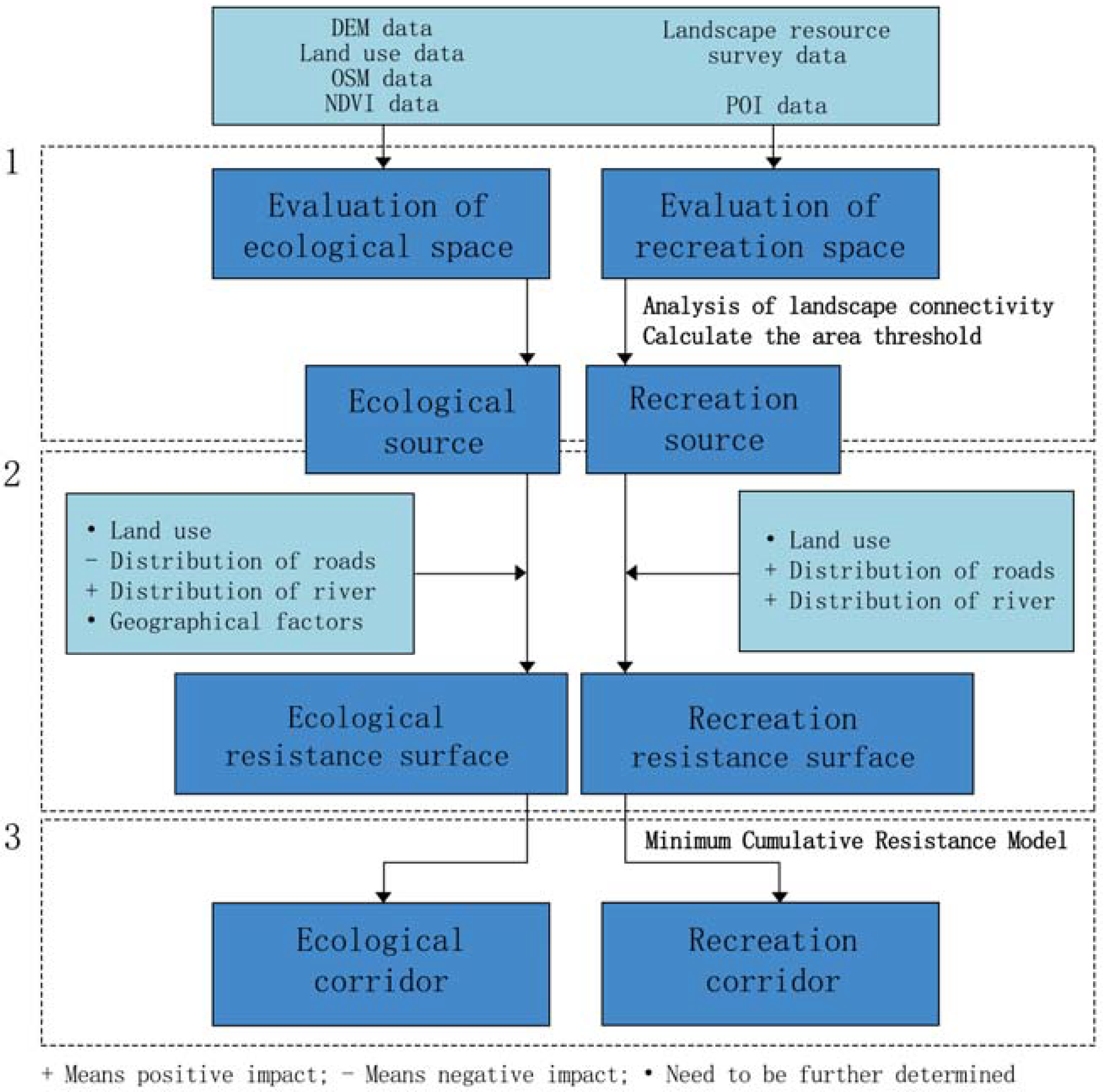
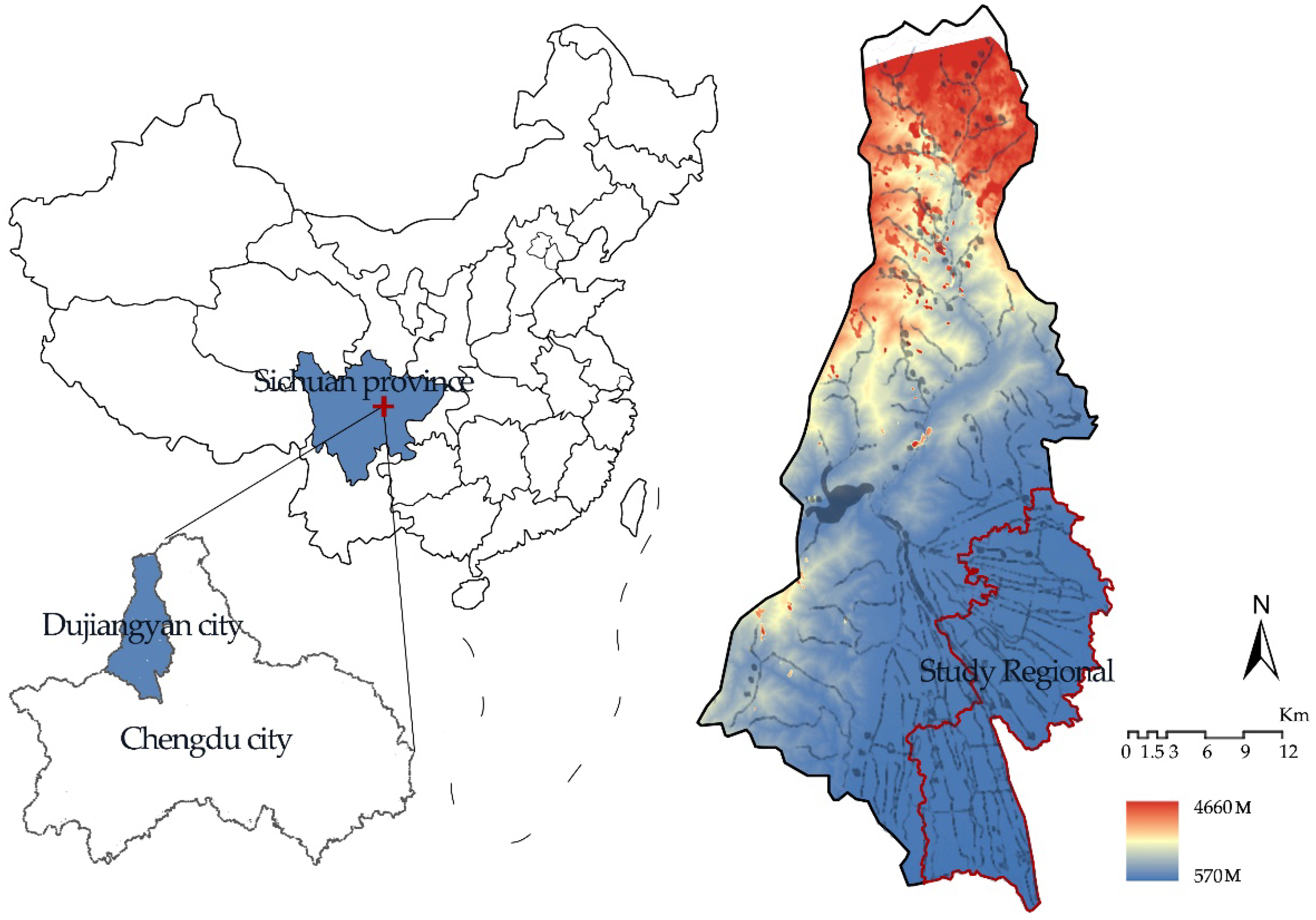
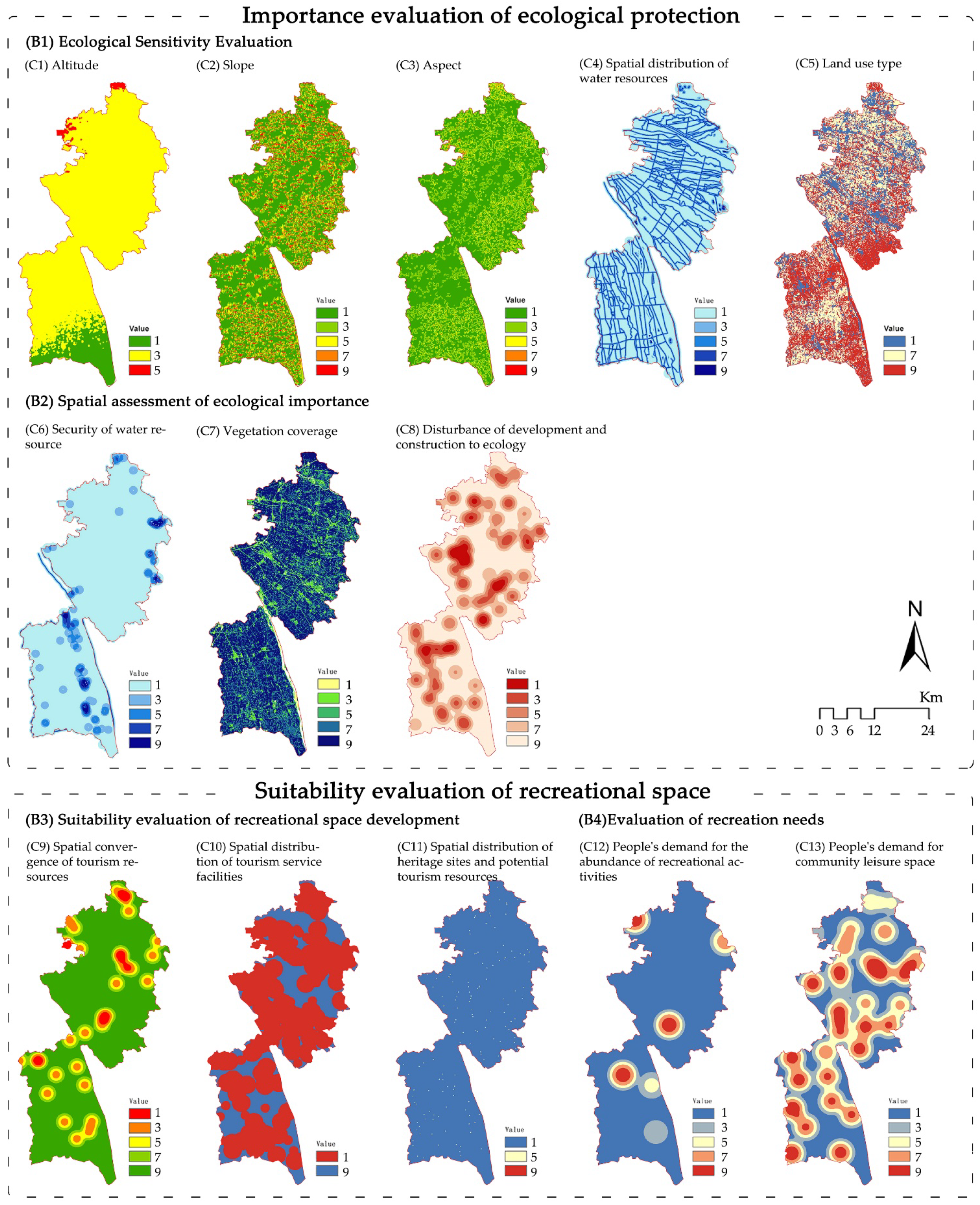
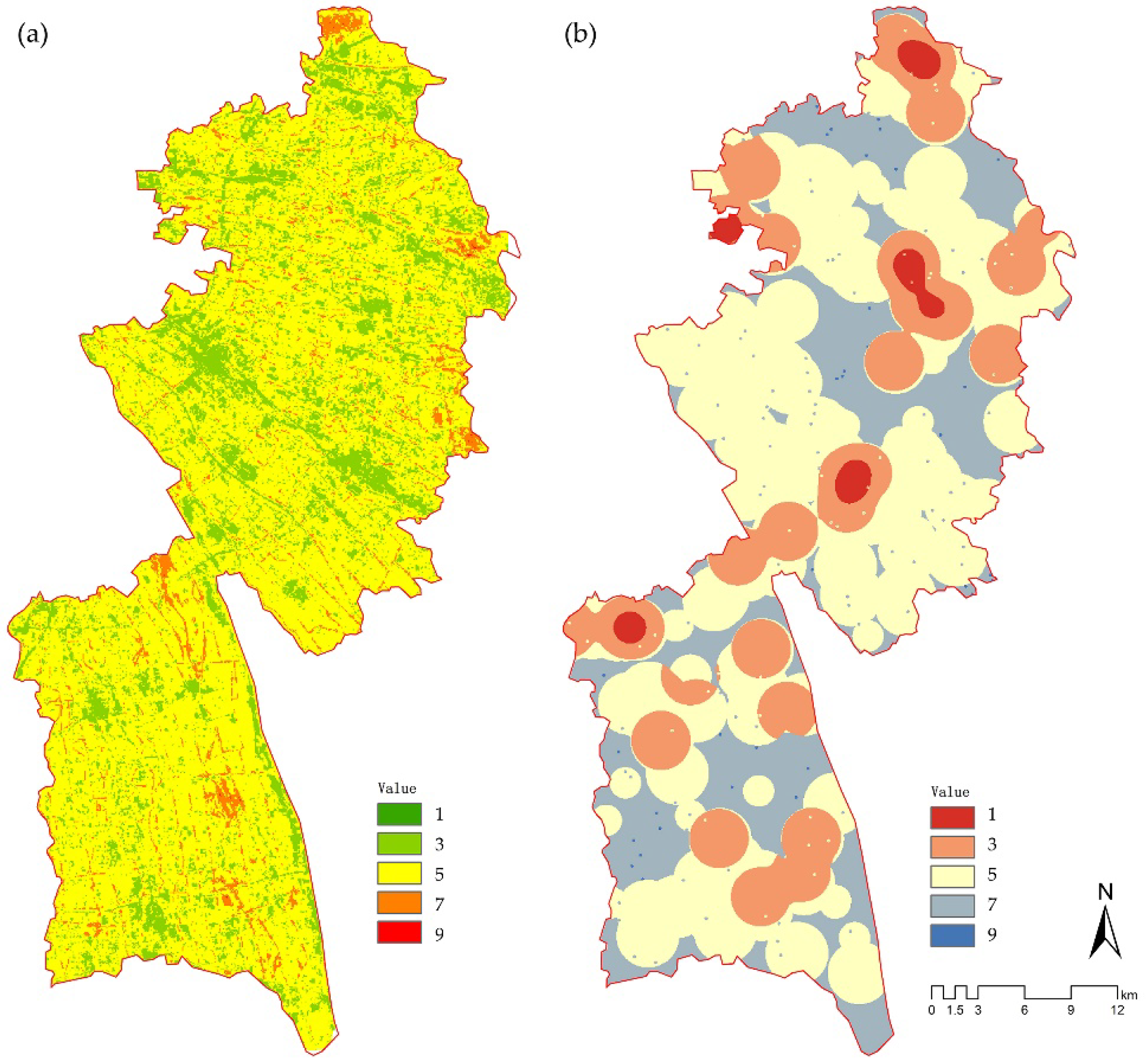



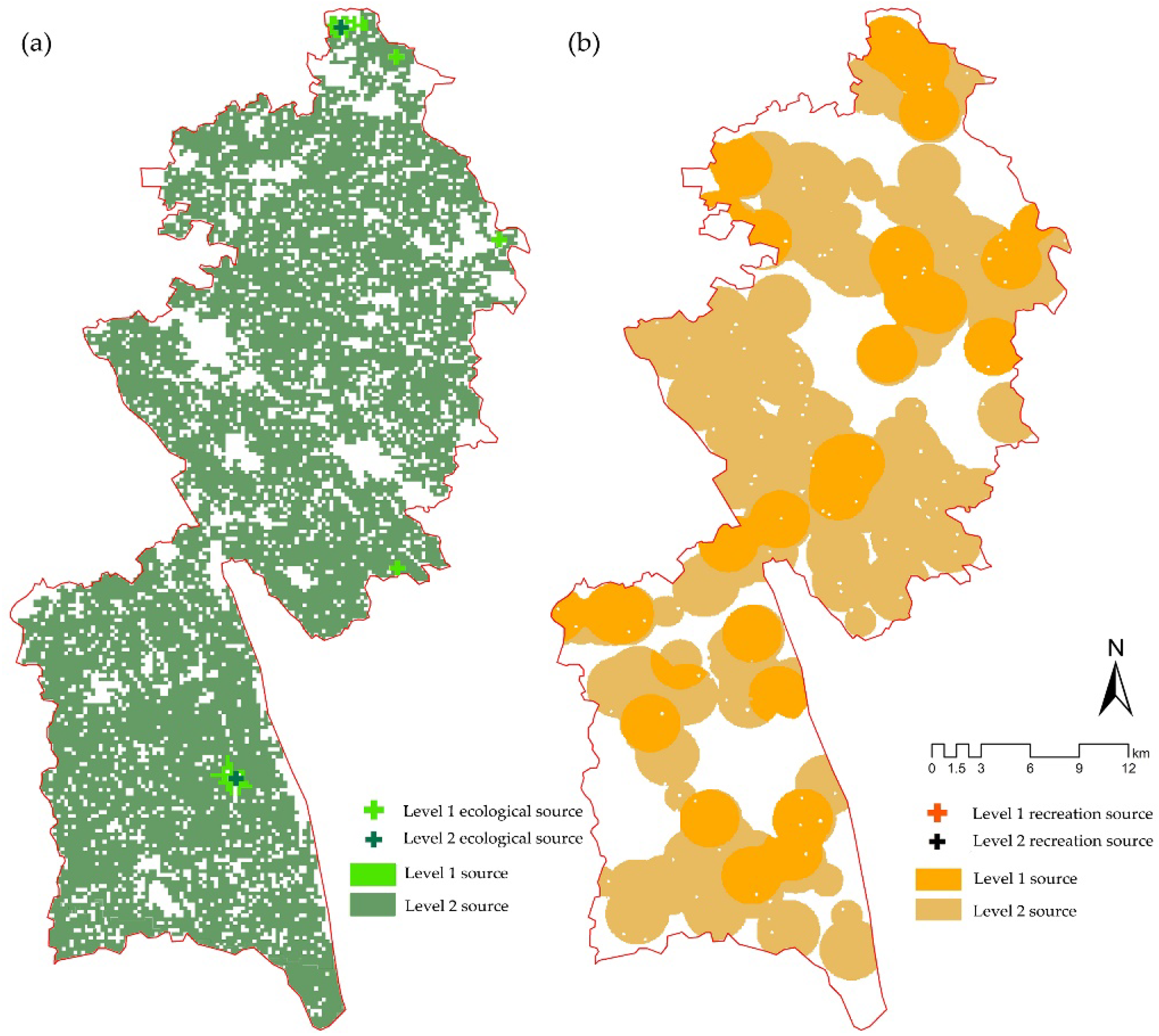


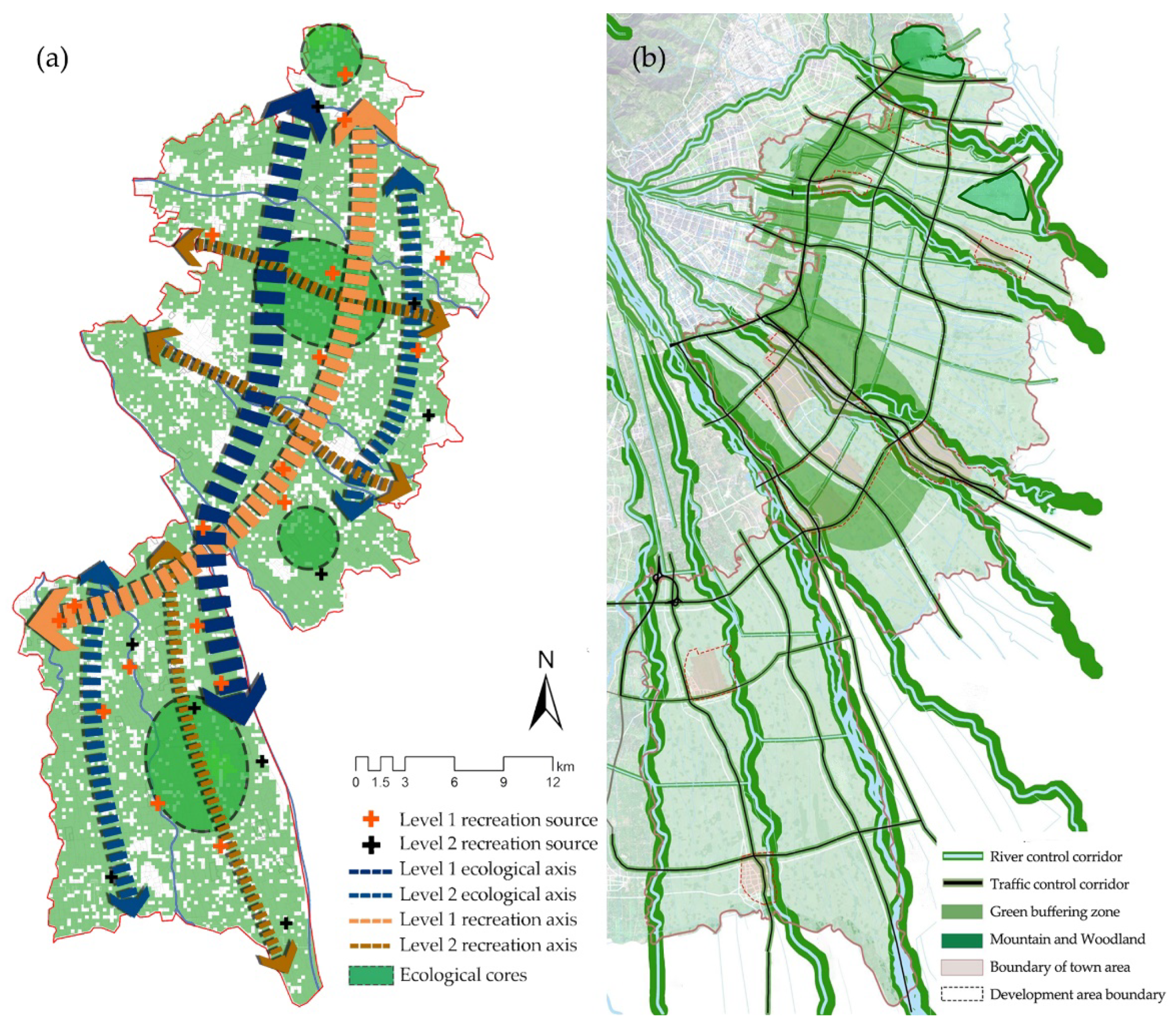
| Interference Factor | Resistance Value | ||
|---|---|---|---|
| Ecological Resistance | Recreational Resistance | ||
| Land-use type | Water | 80 | 10 |
| Woodland | 5 | 5 | |
| Farmland | 50 | 20 | |
| Land for construction | 150 | 80 | |
| Wasteland | 10 | 150 | |
| Road classification | Freeway | 200 | 200 |
| Arterial highway | 150 | 100 | |
| Feeder highway | 100 | 50 | |
| Village road | - | 10 | |
| Water | - | 80 | 10 |
| Topographic | Slope > 25° | 150 | - |
| 8° < Slope < 15° | 10 | ||
| Slope < 3° | 5 | ||
| Index Name | Principal Component Factor | ||
|---|---|---|---|
| Ecological Principal Component Factor | Recreational Principal Component Factor 1 | Recreational Principal Component Factor 2 | |
| CONTAG | 0.983 | 0.929 | −0.324 |
| COHESION | 0.981 | 0.848 | 0.332 |
| DIVISION | 0.712 | 0.317 | 0.939 |
| SHDI | 0.962 | 0.123 | 0.983 |
| SHEI | −0.952 | −0.883 | 0.438 |
| AI | 0.991 | 0.988 | −0.013 |
Publisher’s Note: MDPI stays neutral with regard to jurisdictional claims in published maps and institutional affiliations. |
© 2022 by the authors. Licensee MDPI, Basel, Switzerland. This article is an open access article distributed under the terms and conditions of the Creative Commons Attribution (CC BY) license (https://creativecommons.org/licenses/by/4.0/).
Share and Cite
Dong, Q.; Wu, L.; Cai, J.; Li, D.; Chen, Q. Construction of Ecological and Recreation Patterns in Rural Landscape Space: A Case Study of the Dujiangyan Irrigation District in Chengdu, China. Land 2022, 11, 383. https://doi.org/10.3390/land11030383
Dong Q, Wu L, Cai J, Li D, Chen Q. Construction of Ecological and Recreation Patterns in Rural Landscape Space: A Case Study of the Dujiangyan Irrigation District in Chengdu, China. Land. 2022; 11(3):383. https://doi.org/10.3390/land11030383
Chicago/Turabian StyleDong, Qidi, Linjia Wu, Jun Cai, Di Li, and Qibing Chen. 2022. "Construction of Ecological and Recreation Patterns in Rural Landscape Space: A Case Study of the Dujiangyan Irrigation District in Chengdu, China" Land 11, no. 3: 383. https://doi.org/10.3390/land11030383
APA StyleDong, Q., Wu, L., Cai, J., Li, D., & Chen, Q. (2022). Construction of Ecological and Recreation Patterns in Rural Landscape Space: A Case Study of the Dujiangyan Irrigation District in Chengdu, China. Land, 11(3), 383. https://doi.org/10.3390/land11030383





